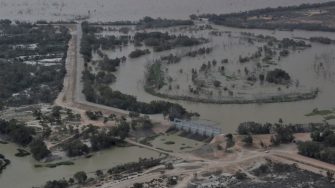
Day 6, Sydney to Broken Hill
Date: Wednesday, October 13, 2021
Project: Eastern Australian Waterbird Survey
Observers: Richard Kingsford & John Porter
Pilot: James Barkell
We headed out from Sydney in inclement weather. There were early signs that it was going to be a difficult day, as we had to go for IFR or Instrument Flight Rules, which meant we had to head into the clouds over the Blue Mountains on our way to our first survey site of Burrendong Dam, near Wellington. We came down out of the clouds near Bathurst, but when we got to Burrendong, the clouds were just sitting too low for us to safely survey the dam and so we stayed high.
We had the same problem over the Macquarie River to the west of the dam. So, we had to make a snap decision to abandon this part of the survey, hoping to pick it up later in the week and we headed for Dubbo to refuel for the long leg to Broken Hill. We took off over brilliant green paddocks, with farm dams brimming with water and the sun was shining, crossing the Macquarie River heading west.
Macquarie River just west of Dubbo.
Conditions were great for flying. There were a few ducks, mostly black duck, grey teal and wood duck, and herons and as well as the odd straw-necked ibis on the flooded dams. After we got out of the cultivated areas, we headed over the rangelands and the density of farm dams decreased. But they were still full. But as we headed further west, and just north of the town of Ivanhoe, it was clear that this part of the country hadn’t had anything like the same rain they had had in the east.
We flew past what is known as the Tallywalka lakes system. These are a string of lakes fed by Tallywalka Creek, a high level distributary creek from the Darling River. The lakes have not held water for some time and were bone dry as usual.
Dry lakes beds of the Tallwalka system
These lakes need a seriously big flood on the Darling River, but virtually nothing has been said about the demise of the great ecosystem, despite the controversy and discussion over the over allocation on the Darling River and the state of Menindee Lakes. The ‘big flood’ down the Darling River recently certainly wasn’t big enough to do anything for this lake system. No one talks much about this major ecological casualty of over development of the Darling River and its tributaries.
The wind really got going as we headed for Menindee Lakes. It had already been a long flight by the time we got to the Darling and so we landed at Menindee for a quick leg stretch before tackling the lakes from the north to south.
The Darling River with the town of Menindee
We headed up to the lakes, surveying the Darling River and its floodplain.
We then headed for Lake Malta, the smallest of the lake with water. It was great to see all the Menindee Lakes full again, after so many dry years. From Lake Malta, we did circuits, surveying Lake Balaka, Bijijie Lake, Tandure Lake and Lake Pamamaroo.
Main Weir across the Darling River – storing water in Lake Wetherell
While the extent of water was impressive across these Menindee Lakes the number of waterbirds weren’t. There were probably no more than a few hundred waterbirds across this huge expanse of water, mostly cormorants, pelicans, swans and grey teal. There was a sea eagle which was great to see. The low numbers of waterbirds doesn’t mean the lakes aren’t any good, ecologically. It means there is a lot of water around elsewhere and so the waterbirds are spread out.
Also, this water will provide habitat for years to come, when other more temporary habitats dry out, providing essential food. Over the lakes, we battled 30-40km/ hr howling winds, which made the plane jump around as we surveyed each lake twice.
Lines of sediment and organic matter blown into lines on the Menindee Lakes
It was soon pretty clear that we weren't going to have enough fuel to finish surveying all lakes today. So once we had finished surveying Lake Pamamaroo, we headed for Broken Hill. That meant picking up the rest of the lakes in the morning.
The channel between Copi Hollow and Lake Menindee where we would start in the morning
By Richard Kingsford
